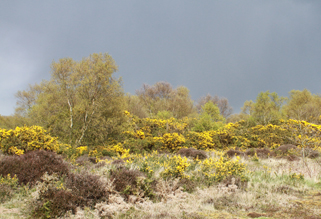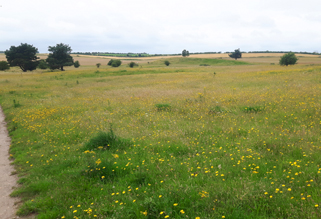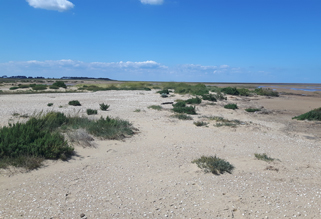Plant Communities
At first glance, plant species might appear to grow pretty much anywhere (and some more or less do!) but on closer inspection, it soon becomes apparent that most species have their preferred habitats - indeed, habitats themselves are essentially a result of assemblages of plant species forming as a result of environmental factors such as soil type and prevailing levels of light and moisture. This results in certain species tending to cluster with each other and these associations of species are often known as plant communities. The differences between some plant communities, for example a woodland compared with a coastal sand dune, can be pretty obvious, while others can be more subtle. These subtleties can be taken to varying degrees and here, a rather broad definition of communities is taken, to create an overview of East Anglia's main habitat types and to aid an understanding of plant distribution in East Anglia.
A degree of interpretation is always required when attempting to neatly divide the fluid nature of natural and semi-natural habitats; an area of wet land dominated by grass, for example, could be considered wet grassland, or a grassy wetland and such areas demonstrate the way that natural habitats often merge seamlessly into each other, rather than fitting neatly into rigid categories. It has sometimes been argued that the only truly natural habitats left in the UK are found on the tops of the highest ground and on mobile, coastal shingle areas (such as Orfordness). All other habitats have been influenced to a greater or lesser degree by humans. This is not as bad as it might at first sound, since at least some of the resulting semi-natural habitats have existed in the UK for some 2,000 years or more and many of our native plant species have become a part of the plant communities that occupy, or even help to define, these habitats. In such plant communities, the method of management (e.g. grazing, harvesting, tilling) is as integral and important as natural, environmental factors in creating and then sustaining the plant communities.
Click on the pictures below to go to the communities that you are interested in.
(For a list of all plant communities on the site, click here)
 |
A. Woodland
Woodlands are plant communities where deciduous or coniferous trees dominate the assemblage of plants. Various types of natural, semi-natural and planted woodland occur in the region, with the range of species present being in part a result of the soil and in part a result of human management of the site. Woodlands can have a rich ground flora beneath them and can be found in a wide range of situations such as on coastal dunes and on either wet or dry soils.
|
 |
B. Scrub
These communities are dominated by small, bushy trees and shrubs, typically with a height of five metres or less. Scrub communities can be dense and impenetrable, or more open, with grassy glades between the woody plants. These communities can be dominated by a single species (most often Hawthorn or Gorse) or can be more diverse in their species structure. Scrub can be a temporary successional habitat that forms on abandoned or disturbed land as a precursor to woodland, or it can be more or less permanent and maintained by climatic conditions or grazing.
|
 |
C. Heathland
Heathland plant communities develop where the soil is acidic and often sandy. Though East Anglia lies largely on chalk bedrock, extensive areas of sandy soils, originating from glacial outwash and wind-blown material have developed on exposed sites and extensive areas of heathland, dominated by gorses and heathers are widespread. Most can be found in coastal East Suffolk and North Norfolk with isolated heaths also in Breckland, on the Norfolk greensand ridge and to the north of Norwich. Heath plant communities can also develop on coastal sand dunes.
|
 |
D. Grassland
This covers quite a range of different plant communities, but all can be identified by their predominance of grass species. Soil type has a large influence on the plant communities that develop and chalky soils can produce the most species-rich communities, especially in the west of our region. In addition to soil type, both wet and dry grasslands can develop, according to local conditions and many semi-natural grasslands are maintained through grazing, especially in coastal and river valley habitats.
|
 |
E. Wetland
This section covers a whole range of habitats where water is a major influence. Wetlands can range from open, standing fresh or saltwater lakes and lagoons, through rivers, ditches and dykes to more or less permanently damp ground that forms bogs on acid soils and fen on chalky soils. A wide range of plant communities develops in wetlands, from plants tolerant of having saturated roots, through emergent plants in seasonally or permanently wet places, to true aquatics that grow submerged beneath the water surface in permanent water bodies.
|
 |
F. Coastal Communities
A wide range of plant communities can be found around East Anglia's coastline, with soil and amount of saltwater inundation playing important roles in what develops. Plants can form distinctive strandline communities on sandy beaches, while sand dunes and cliffs have their own communities, too. Saltmarsh holds a highly distinctive range of habitats from low, through mid to high saltmarsh, where plants need to be highly adapted to cope with the growing conditions. Coastal grazing marshes and grasslands can also develop plant communities that differ from those found further inland as the plant species need to cope with the salt in the air or soil.
|
 |
G. Farmland
East Anglia is without doubt a highly farmed region, with open, arable fields of cereal, sugar beet and rape dominating the bulk of our landscapes. These highly managed habitats are difficult places for plant communities to develop and most often the species will be annuals that can complete a life cycle between cropping regimes. As with other plant communities, those of arable land vary according to soil type as well as to management practices and the chalky soils of the west of our region can hold a very different suite of species to those found on the sandy soils of North Norfolk, East Suffolk and Breckland.
|
 |
H. Anthropic Communities
The increasing presence of humans in the landscape provides a whole range of habitats for plants to exploit. In inner cities and towns, the presence of walls and pavement introduces opportunities for new plant communities to form and these often include not just native opportunists, but also non-native species that spread from plantings in gardens and parks. This section also includes habitats that can become semi-natural but which were originally created by human landscaping, such as churchyards and cemeteries, brownfield sites and allotments. Churchyards in particular have become increasingly important places for some interesting grassland species.
|